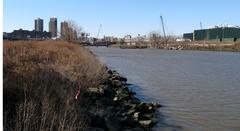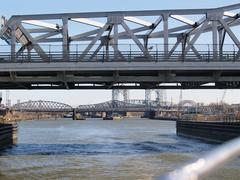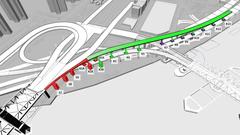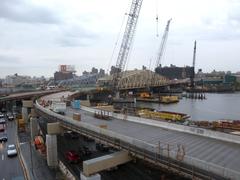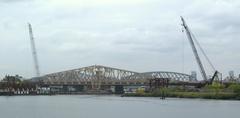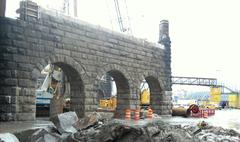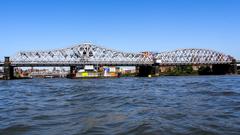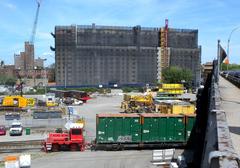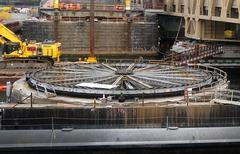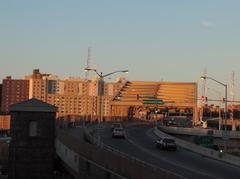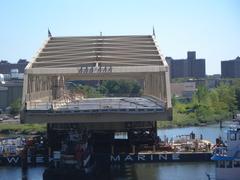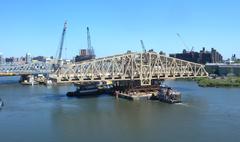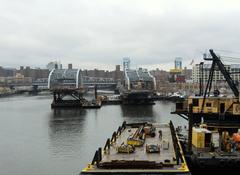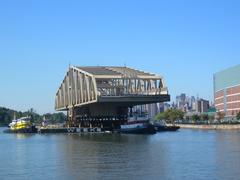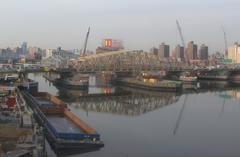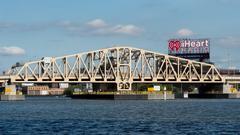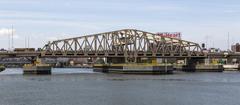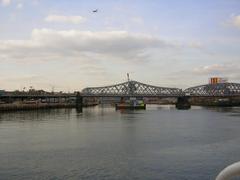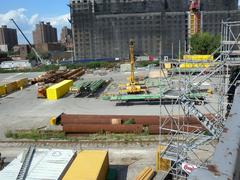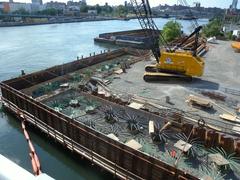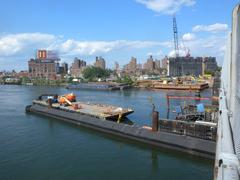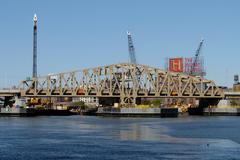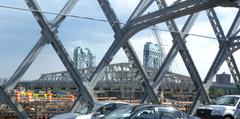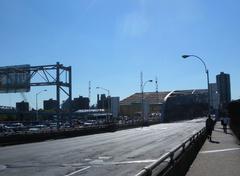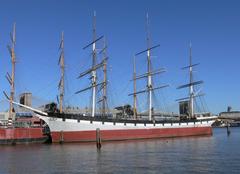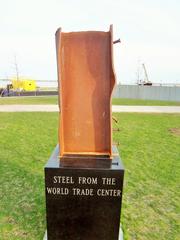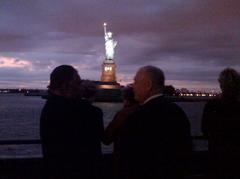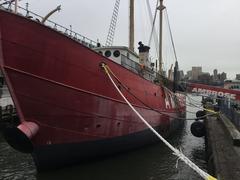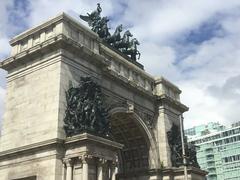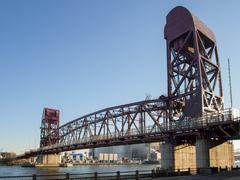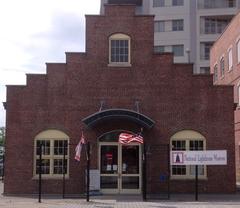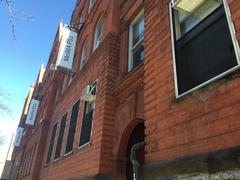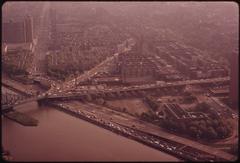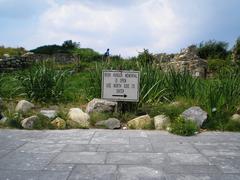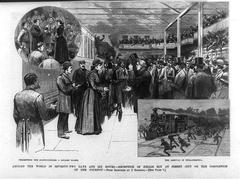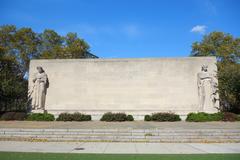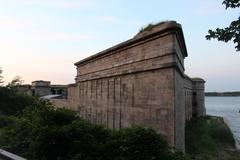
Visiting Hours and Tickets for Willis Avenue Bridge in New York City
Published Date: 19/07/2024
Introduction to Willis Avenue Bridge
The Willis Avenue Bridge is a vital piece of infrastructure that connects Manhattan and the Bronx, playing a significant role in New York City’s urban landscape. First opened in 1901, the bridge was originally designed by engineer Thomas C. Clarke as a swing-type bridge to accommodate the bustling maritime activities on the Harlem River. This design choice was essential for preserving the economic vitality of the region by facilitating the seamless movement of goods and people (NYC DOT). Over the decades, the bridge underwent numerous modifications to keep pace with technological advancements and growing traffic demands. By the late 20th century, a comprehensive evaluation led to the construction of a new, modern bridge, which officially opened in October 2010. This new structure is a fixed, steel arch bridge designed to enhance durability and reduce maintenance complexities (NYC Bridges). The Willis Avenue Bridge stands as a testament to the continuous evolution of engineering and urban planning in New York City, reflecting the city’s resilience and adaptability.
Table of Contents
History of the Willis Avenue Bridge
Early Conception and Construction
The Willis Avenue Bridge was constructed in 1901, designed by the prominent engineer Thomas C. Clarke. The bridge was a response to the increasing need for improved transportation routes between the boroughs, driven by the rapid industrial growth and urban expansion of New York City during that period. The original bridge was a swing-type bridge, allowing it to pivot horizontally to let river traffic pass. This design was crucial for accommodating the bustling maritime activities on the Harlem River. The original structure was 3,120 feet long and 52 feet wide, featuring a roadway and pedestrian walkways on either side. The construction cost was approximately $2.5 million, a significant investment reflecting the bridge’s anticipated importance.
Technological Advancements and Modifications
Over the decades, the Willis Avenue Bridge underwent several modifications to address the evolving transportation needs and technological advancements. In the 1950s, the bridge was widened to accommodate increased vehicular traffic, reflecting the post-World War II boom in automobile ownership. This period also saw the introduction of more robust materials and construction techniques, enhancing the bridge’s durability and load-bearing capacity. Despite these upgrades, by the late 20th century, the bridge faced significant wear and tear. The increasing traffic volumes and the natural aging of materials necessitated a comprehensive evaluation of the bridge’s structural integrity. In the 1990s, the New York City Department of Transportation (NYCDOT) initiated studies to assess the feasibility of either rehabilitating the existing structure or constructing a new bridge.
The New Willis Avenue Bridge
After extensive deliberation, the decision was made to construct a new bridge. The new Willis Avenue Bridge project commenced in 2007, with the goal of creating a modern, efficient, and safer structure. The new bridge was designed as a fixed, steel arch bridge, eliminating the need for a swing mechanism and thereby reducing maintenance complexities and costs. The construction of the new bridge was a monumental task, involving advanced engineering techniques and meticulous planning to minimize disruptions to the existing traffic flow. The new bridge was built adjacent to the old one, allowing the latter to remain operational during the construction phase. This approach exemplified modern engineering practices aimed at balancing infrastructure development with urban functionality. The new Willis Avenue Bridge was officially opened to traffic on October 2, 2010. The project cost approximately $612 million, reflecting the scale and complexity of the undertaking. The new bridge spans 3,400 feet and features wider lanes, improved pedestrian walkways, and dedicated bicycle paths, aligning with contemporary urban mobility trends.
Historical Significance
The Willis Avenue Bridge holds significant historical value, not only as a critical transportation link but also as a testament to the evolution of engineering and urban planning in New York City. The bridge’s history mirrors the broader narrative of the city’s growth, industrialization, and modernization. The original bridge was a marvel of early 20th-century engineering, embodying the ingenuity and ambition of its era. Its construction facilitated the seamless movement of goods and people, contributing to the economic vitality of both Manhattan and the Bronx. The bridge also played a crucial role during the Great Depression and World War II, serving as a vital conduit for industrial and military logistics. The transition to the new bridge in the 21st century underscores the continuous advancement in engineering and urban infrastructure. The new bridge’s design and construction reflect contemporary priorities, such as sustainability, safety, and multimodal transportation. It stands as a symbol of New York City’s resilience and adaptability, capable of meeting the demands of a dynamic urban environment.
Preservation and Legacy
While the original Willis Avenue Bridge no longer stands, its legacy is preserved through various historical records and commemorations. The bridge’s history is documented in numerous archives, including the New York City Department of Transportation and the Library of Congress. These records provide valuable insights into the bridge’s construction, modifications, and impact on the city’s development. The new Willis Avenue Bridge continues to serve as a vital transportation link, facilitating the movement of thousands of vehicles, pedestrians, and cyclists daily. Its design incorporates elements that pay homage to its predecessor, ensuring that the historical significance of the original bridge is not forgotten. In conclusion, the history of the Willis Avenue Bridge is a rich tapestry of engineering innovation, urban growth, and historical significance. From its inception in the early 20th century to its modern incarnation, the bridge has played a pivotal role in shaping the transportation landscape of New York City. Its story is a testament to the enduring spirit of progress and the continuous quest for improvement in urban infrastructure.
Visitor Information
Ticket Prices and Visiting Hours
Visiting the Willis Avenue Bridge does not require tickets as it is a public infrastructure. The bridge is accessible 24/7, allowing visitors to explore it at any time of the day. However, it is advisable to visit during daylight hours for safety reasons and to fully appreciate the scenic views of the Harlem River and the surrounding areas.
Travel Tips and Accessibility
The Willis Avenue Bridge is easily accessible by various modes of transportation. Visitors can reach the bridge via the NYC subway, bus services, or by driving. There are pedestrian walkways and dedicated bicycle paths for those who prefer walking or cycling. It is recommended to wear comfortable shoes and bring water, especially during the summer months.
Nearby Attractions
While visiting the Willis Avenue Bridge, there are several nearby attractions worth exploring:
- Randall’s Island Park: A large park offering sports facilities, scenic walking paths, and event spaces (Randall’s Island Park).
- Harlem River Park: A waterfront park with green spaces, playgrounds, and beautiful views of the Harlem River.
- The Bronx Museum of the Arts: A cultural institution showcasing contemporary art and cultural exhibitions.
- Yankee Stadium: Home of the New York Yankees, offering tours and a rich history of baseball.
Conclusion
The Willis Avenue Bridge is more than just a transportation link; it is a symbol of New York City’s engineering prowess and historical legacy. Whether you are a history enthusiast, an engineering aficionado, or simply a curious traveler, the bridge offers a unique glimpse into the city’s past and present. Plan your visit to the Willis Avenue Bridge to experience this remarkable piece of New York City’s infrastructure firsthand.
Summary and Key Points
In summary, the Willis Avenue Bridge is much more than a transportation link between Manhattan and the Bronx; it is a historical landmark that embodies the spirit of New York City’s growth and modernization. Since its original construction in 1901, the bridge has been a critical component of the city’s infrastructure, adapting to technological advancements and increased traffic demands over the years. The transition to the new bridge in 2010 symbolizes the city’s commitment to sustainability, safety, and multimodal transportation. Today, the Willis Avenue Bridge continues to facilitate the movement of thousands of vehicles, pedestrians, and cyclists daily, while also offering beautiful views of the Harlem River and the Manhattan skyline (Library of Congress, Randall’s Island Park). For those interested in exploring this iconic landmark, the bridge is easily accessible via public transportation and offers a variety of nearby attractions, making it a must-visit for both locals and tourists alike.
References and Sources
- NYC DOT, 2024, Department of Transportation source URL
- NYC Bridges, 2024, New York City Department of Transportation source URL
- Library of Congress, 2024 source URL
- Randall’s Island Park, 2024 source URL

